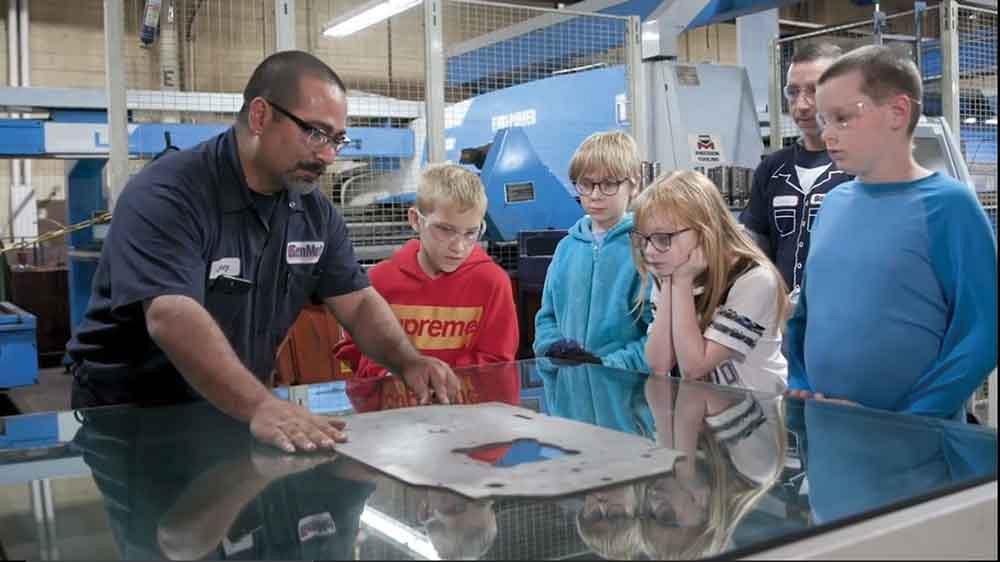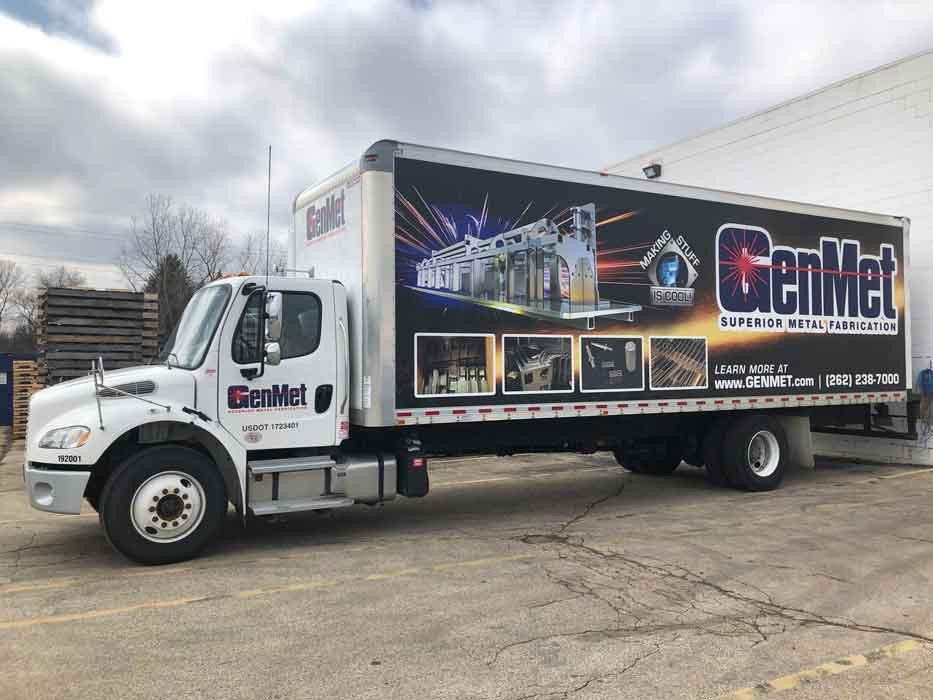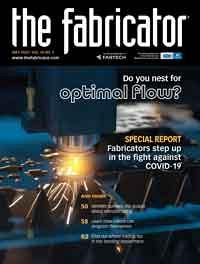Editor-in-Chief
- FMA
- The Fabricator
- FABTECH
- Canadian Metalworking
Categories
- Additive Manufacturing
- Aluminum Welding
- Arc Welding
- Assembly and Joining
- Automation and Robotics
- Bending and Forming
- Consumables
- Cutting and Weld Prep
- Electric Vehicles
- En Español
- Finishing
- Hydroforming
- Laser Cutting
- Laser Welding
- Machining
- Manufacturing Software
- Materials Handling
- Metals/Materials
- Oxyfuel Cutting
- Plasma Cutting
- Power Tools
- Punching and Other Holemaking
- Roll Forming
- Safety
- Sawing
- Shearing
- Shop Management
- Testing and Measuring
- Tube and Pipe Fabrication
- Tube and Pipe Production
- Waterjet Cutting
Industry Directory
Webcasts
Podcasts
FAB 40
Advertise
Subscribe
Account Login
Search
Meet the fabricator that knows the importance of local manufacturing support
Revisiting Industry Award winners: GenMet Corp. embraces its role as an apostle for modern-day metal fabricating
- By Dan Davis
- May 5, 2020
- Article
- Shop Management

During a recent Manufacturing Day open house event, GenMet welcomed elementary schoolers from the area. They got lessons on how a metal fabrication company operates, including how quality checks are made using a scanner.
If you see the GenMet Corp. box truck making deliveries in the Milwaukee metro area, you’ll notice not just the company logo on the side, but also pictures of several fabrications and a badge that states, “Making stuff is cool!” The message is almost as important as the contents of the truck.
“I want customers to see the truck and say, ‘Hey, they make stuff like we need.’ I also want little Johnny or little Sally in the back seat of a minivan to look up at the truck and say, ‘I want to make that,’” said GenMet Corp. CEO Eric Isbister.
That’s how it’s been pretty much since Eric and his wife Mary, the company’s president, purchased the company 20 years ago. Making metal parts efficiently and delivering those quality parts on time is obviously the main goal, but to grow a business and add to the company’s skill base, you need fabricating talent, which is not the easiest thing to find in a tight labor market. That’s why GenMet has always tried to elevate manufacturing’s profile, hoping to inspire the next generation to consider a career in manufacturing, while perhaps nabbing an employee or two along the way.
The FABRICATOR last visited with GenMet at its Mequon, Wis., facility in December 2009 for a February 2010 cover story. The fabricator had just won the publication’s Industry Award for its efforts in streamlining its fabricating operations, reducing its finished-goods inventory, and its commitment to internal training. In the 10 ensuing years, some things have changed, while others have not. GenMet has refocused its business strategy and doubled-down on its key resource—its own people.
What Has Changed
Eric Isbister said that GenMet is working its way back to revenue levels of around $10 million, similar to what it was back in 2009. But instead of doing a lot of laser cutting, bending, and shipping of parts, the company is now pursuing higher-value-added work.
“We want to be hired for our brains, not just for our machines,” he said.
That means more engineering involvement in these large projects and, typically, more welding. As an example, Isbister described a large brushed stainless steel machine it built for a manufacturer of finishing machines. This particular device, about the size of a refrigerator, is used to deburr 3D-printed parts.
The 14 welders on staff are challenged with these large weldments on a regular basis. They aren’t laying the same bead on a crane assembly each and every day. They need to be able to read prints on a computer, set their own welding machines, retrieve their own components, maybe build a fixture, check their own work, and then engage someone else to get the final check. You can’t hide from responsibility in this shop.
“When you challenge people, they’re inclined to stay as opposed to getting bored,” Isbister said.
The push to find more value-added work was the result of a strategic planning meeting about five years ago. The company also was in the midst of trying to diversify its customers base, a lesson that it and other shops learned from the economic turbulence of a decade ago.

GenMet’s truck not only advertises the company’s fabricating services, but also aims to inspire the next generation of manufacturers with a simple message: “Making stuff is cool!”
The goal is to find customers that may not be attached to the same economic cycle. That way when a market sector slows down, other segments still may be chugging along. That keeps the quotes coming, and the shop floor busy. This approach may not provide the big rewards of serving a few companies in a red-hot manufacturing sector, but diversification minimizes the risk of a majority of work drying up when that one red-hot sector cools.
What Hasn’t Changed
When asked what the biggest challenge has been over the past decade, Isbister joked that the interviewer already knew the answer. It’s the same challenge from 10 years ago.
“It’s finding talent,” he said, “but it’s not only getting people, it’s finding the right people. We need a different type of person today. For example, if we’re going to get into robotic welding, we need a person who’s going to be smart enough to learn how to program and who has a passion to make the robot welding cell work. Unfortunately, those types of people are few and far between.”
Isbister said that GenMet’s 46 employees are an “amazing” team. They don’t spend a lot of time grousing about things, but instead offer a hand to their co-workers to see if they can help them out.
The Isbisters have been working to develop this type of environment since they purchased the business. This was particularly evident 10 years ago when the company had just completed its ISO certification. Isbister said it got people to open their eyes and see what everyone contributed to the overall success of the organization.
“One of the best things about ISO certification was that each employee learned about the other people’s jobs,” he said. “A production employee might have thought that the office people just sat around in the air-conditioned office, but after they heard the metrics that were generated from the office, they admitted that they didn’t want to do that and were glad someone else was doing it.
“People realized that everybody had hard jobs and that everybody was a member of the same team.”
Isbister said that the Wisconsin Manufacturing Extension Partnership (MEP) has been extremely helpful over the years with projects like ISO certification. (Mary Isbister is a former chair of Wisconsin MEP’s board of directors and currently serves on the National Institute of Standards and Technology MEP advisory board.) The MEP consultants also have assisted with lean manufacturing efforts, such as implementing 5S on the shop floor.
These consultants also have helped people to find their own voices, allowing them to step forward and share their thoughts on how things should be done. Isbister said that this desire to offer input led to the creation of what the company calls “yellow sheets,” based on the color of said forms.
On these sheets, employees can offer suggestions, some big in scope and others small, and they have to sign their names on the form. The forms are then shared at the all-hands meetings on Mondays, where employees are all brought into a conference room. (This practice was temporarily shelved in light of the COVID-19 crisis occurring in March.)
“We review these items at the all-hands meetings. Employee A sees what Employee B has submitted, and he says, ‘Yeah, I’ve got this similar thing,’” Isbister said. “It just snowballs. That’s just another example of having a good team of people that help each other out.”
GenMet considers the yellow sheets generated by workers to be a key part of their annual performance appraisals. If they are engaging through these yellow sheets, they are actively thinking of ways to improve internal operations, making the employee more valuable to the company.
That same type of thinking is employed in skills development at GenMet. If employees want to increase their worth—and potentially compensation—they can choose to pursue skill development. Once a skill has been mastered, the employee gets a “smart card,” and only those employees with smart cards are allowed to do the jobs for which they are trained.
“If you just sit on your hands and don’t aggressively go after getting smart cards, you’re not going to do as well as your co-worker who’s after it,” Isbister said.
To get a smart card, an individual has to go through training with the lead person in that particular area. For example, if a person wants to become a laser machine operator, he or she has to coordinate with the lead in that department. Training takes place, and when the lead thinks the person is ready, that individual has to complete six jobs without complications, with the lead overseeing each one. If all is done according to expectations, the lead signs off on the smart card, and GenMet has a new laser machine operator.
Leads can consult one of about 60 computers on the GenMet shop floor to see which employees have what smart cards. It’s a living document of expertise.
Isbister added that some processes have multiple levels of smart cards. For example, in bending, smart cards exist for setup, operator, and mentor levels. In another example, smart cards for quality at the source include 2D and 3D quality checks, final checks, and incoming inspection (when a part is delivered).
New hires almost always start their shop floor career pulling parts from laser-cut sheets. With some experience, they usually gravitate to processes such as etching numbers on parts or shearing bar stock on an ironworker, where the smart cards are easier to obtain.
“It’s interesting to see people grow here,” he said. “Maybe they’re shy and reserved when they get here, but they usually open up. They realize that only they can make themselves the best they can be.”
GenMet also is committed to the type of training that is more familiar to those in the metal fabricating trade. It is close to having one of its most recent hires achieve his journeyman status after taking classes at nearby Waukesha County Technical College and completing on-the-job training at GenMet. The company also usually has two to three youth apprentices, who work full-time in the summer and part-time during their senior year of high school.
When it comes to welding, Isbister said he’s kind of “persnickety.” He worked for the Electric Boat Division of General Dynamics, Groton, Conn., building nuclear submarines for more than 20 years, so quality welds are the only allowable welds in his world.
“I don’t let anybody weld for customers until they pass the AWS certification test,” Isbister said. And new welders don’t get a crack at the certification test until they have demonstrated to one of the lead welders that they are ready for the test. At that time, GenMet brings in a third-party certified welding inspector to administer the test.
What Continues to Happen
Even with his eye on the business and fostering a winning culture at GenMet, Isbister still is committed to making his company visible to those in nearby communities. Manufacturing Day, typically in early October, is a prime opportunity to connect with students of all ages, and GenMet takes full advantage.
The company hosted about 140 students on Manufacturing Day 2019. Isbister said the most fun he had was with a group of fourth-graders. He had them around a table with a bunch of parts and asked them to determine what was wrong with the parts by consulting corresponding blueprints. Using tools like calipers and tape measures and working together, the students found the flaws, like a welded part that was attached the wrong way.
“It’s fun to see them high-five each other when they find out what was wrong,” he said.
GenMet also invites the local welding supply company to attend with its welding simulator. The students are able to lay beads in a virtual setting and actually receive a score from the system. That type of competition gets them fired up and excited about the welding craft.
“It’s not that these students consciously don’t want to go into manufacturing or don’t want to go into engineering. It’s that they just don’t know what manufacturing is or what engineers do,” Isbister said.
The same can be said of some of the students’ teachers. Those entering the teaching profession now are likely the children of parents that really had no idea what manufacturing was either. They are just another generation removed from when manufacturing occupied a much larger space in the U.S. landscape 50 years ago.
GenMet actually brings in a teacher from a local high school each summer to work and learn what modern metal fabricating is all about. In fact, it’s done that for six summers. Isbister said the hope is that the teacher can go back to the school’s metal shop and share real-world stories as to why these skills are necessary in the world and the opportunities that await those that might be looking for a career where they can use their hands and creativity.
Isbister admitted that GenMet probably has gotten only one or two employees from this public outreach over the years, but the effort is part of a bigger picture. Supporting manufacturing makes sense for his business, but it also makes sense for the local community. These types of jobs are stepping stones to fulfilling careers and help to keep people at home, instead of chasing career leads in other metro areas.
They also can help to jump-start companies. When it comes to investing in new fabricating technology, Isbister said that his building is pretty full. “I can’t add a stapler without moving a wall,” he said. But he does plan to look at more robotic welding technology. Why? He has a relatively new hire who has a real thirst to dive into the technology. He had already earned smart cards related to operating the laser cutting machine, bending, welding, and quality checks in a short amount of time. He wants to learn as much as possible.
“They make it work. They make a process efficient. They make it a good risk to buy new technology,” Isbister said.
Metal fabricating may be dependent on technology to produce parts to customer specifications, but only engaged employees can make that happen efficiently and cost-effectively. It’s a pretty cool aspect of making things in modern manufacturing.
GenMet Corp., www.genmet.com
About the Author

Dan Davis
2135 Point Blvd.
Elgin, IL 60123
815-227-8281
Dan Davis is editor-in-chief of The Fabricator, the industry's most widely circulated metal fabricating magazine, and its sister publications, The Tube & Pipe Journal and The Welder. He has been with the publications since April 2002.
subscribe now

The Fabricator is North America's leading magazine for the metal forming and fabricating industry. The magazine delivers the news, technical articles, and case histories that enable fabricators to do their jobs more efficiently. The Fabricator has served the industry since 1970.
start your free subscription- Stay connected from anywhere

Easily access valuable industry resources now with full access to the digital edition of The Fabricator.

Easily access valuable industry resources now with full access to the digital edition of The Welder.

Easily access valuable industry resources now with full access to the digital edition of The Tube and Pipe Journal.
- Podcasting
- Podcast:
- The Fabricator Podcast
- Published:
- 04/16/2024
- Running Time:
- 63:29
In this episode of The Fabricator Podcast, Caleb Chamberlain, co-founder and CEO of OSH Cut, discusses his company’s...
- Trending Articles
Capturing, recording equipment inspection data for FMEA

Tips for creating sheet metal tubes with perforations

Are two heads better than one in fiber laser cutting?

Supporting the metal fabricating industry through FMA

Omco Solar opens second Alabama manufacturing facility

- Industry Events
16th Annual Safety Conference
- April 30 - May 1, 2024
- Elgin,
Pipe and Tube Conference
- May 21 - 22, 2024
- Omaha, NE
World-Class Roll Forming Workshop
- June 5 - 6, 2024
- Louisville, KY
Advanced Laser Application Workshop
- June 25 - 27, 2024
- Novi, MI


























